Cinema, often referred to as the seventh art, has undergone an extraordinary transformation since its inception in the late 19th century. From the flickering, silent black-and-white images to today’s CGI-laden blockbusters with billion-dollar budgets, the journey of film is one of continuous innovation, creativity, and cultural reflection. This article traces the rich and fascinating evolution of cinema, exploring the pivotal eras that shaped the medium into the global powerhouse it is today.
The Birth of Cinema – Silent Films (1890s–1920s)
Cinema began as a novelty, a technical curiosity invented to capture moving images. Pioneers like Thomas Edison, Auguste and Louis Lumière, and Georges Méliès were instrumental in developing the first motion picture devices and narratives.
Key Characteristics:
- Silent: These films lacked synchronized sound and dialogue. Music was often played live in theaters to accompany the visuals.
- Black and White: Color had not yet been introduced, although hand-painted film reels were occasionally used.
- Short Length: Early films lasted a few minutes due to technical limitations.
Iconic Films and Figures:
- A Trip to the Moon (1902) – Georges Méliès
- The Great Train Robbery (1903) – Edwin S. Porter
- The Kid (1921) – Charlie Chaplin
The silent era also saw the rise of movie stars, film studios, and the foundations of Hollywood.
The Talkies – Introduction of Sound (1927–1930s)
The release of The Jazz Singer in 1927 marked a revolution. As the first film with synchronized dialogue, it changed the industry forever.
Key Innovations:
- Synchronized Soundtracks: Dialogue, music, and sound effects could now be recorded and played in sync with the film.
- New Genres: Musicals and comedies flourished.
- Improved Storytelling: Dialogue allowed for more complex narratives and character development.
This era also led to a transformation in acting techniques, set design, and directorial approaches. Actors now had to adapt from silent gestures to natural speech, and directors began using sound as a storytelling tool.
The Golden Age of Hollywood (1930s–1950s)
This period marked Hollywood’s peak as the world’s dominant film industry. Studios like MGM, Warner Bros., Paramount, and Universal churned out films across genres.
Features of the Golden Age:
- Studio System: Major studios controlled every aspect of production and distribution.
- Genre Development: Westerns, film noir, romantic dramas, and screwball comedies became staples.
- Technicolor: Films like The Wizard of Oz (1939) and Gone with the Wind (1939) showcased vibrant color palettes.
Legendary Stars and Directors:
- Humphrey Bogart, Marilyn Monroe, James Stewart, Audrey Hepburn
- Alfred Hitchcock, Billy Wilder, Orson Welles
This era gave birth to cinematic masterpieces and established enduring storytelling traditions.
International Movements and Innovations (1950s–1970s)
While Hollywood thrived, the rest of the world also made its mark on cinema.
Influential Movements:
- Italian Neorealism (Bicycle Thieves, Rome, Open City)
- French New Wave (Breathless, The 400 Blows)
- Japanese Cinema – Directors like Akira Kurosawa gained international acclaim.
These movements emphasized realism, experimentation, and social commentary, inspiring directors worldwide to rethink storytelling and technique.
In the U.S., the decline of the studio system gave rise to “New Hollywood,” where directors like Martin Scorsese, Francis Ford Coppola, and Stanley Kubrick gained creative control, resulting in bold, groundbreaking films.
The Rise of the Blockbuster (1970s–1990s)
The modern blockbuster era was born with Steven Spielberg’s Jaws (1975) and George Lucas’s Star Wars (1977). These films transformed how movies were marketed and consumed.
Characteristics of Blockbusters:
- High Budgets: Lavish production values and marketing efforts.
- Wide Releases: Nationwide or global launches instead of limited regional openings.
- Merchandising: Toys, books, and spin-offs became major revenue streams.
Iconic Films:
- E.T., Indiana Jones, Titanic, Jurassic Park, The Matrix
This era also saw the emergence of franchises and the use of computer-generated imagery (CGI), further transforming cinematic possibilities.
Digital Revolution and the Streaming Era (2000s–Present)
The 21st century brought dramatic changes in how films are made and consumed.
Key Developments:
- Digital Filmmaking: Cameras and editing software replaced traditional film stock.
- Visual Effects: CGI and motion capture revolutionized storytelling.
- Franchises and Cinematic Universes: Marvel, DC, Harry Potter, and others created interconnected film worlds.
- Streaming Services: Netflix, Amazon, Disney+, and others reshaped distribution and access.
Modern audiences now enjoy instant access to a global library of films from their devices. The pandemic accelerated the shift to streaming, forcing studios to adapt their release strategies.
The Future of Cinema
Cinema is entering a new era shaped by technology and evolving audience preferences.
What Lies Ahead?
- Virtual Reality (VR) & Augmented Reality (AR): Immersive experiences are gaining ground.
- Artificial Intelligence (AI): AI is increasingly used in editing, VFX, and even screenwriting.
- Global Collaboration: Co-productions across borders are becoming more common.
- Diversity & Inclusion: The push for representation is reshaping casting and storytelling.
While the platforms and technologies may change, the core of cinema—emotionally resonant storytelling—remains timeless.
FAQs: Evolution of Cinema
Q1: What was the first movie ever made?
A1: The first motion picture is often credited to Roundhay Garden Scene (1888) by Louis Le Prince. However, The Horse in Motion (1878) by Eadweard Muybridge is another early example of motion capture.
Q2: When did color films become popular?
A2: Color was experimented with as early as the 1900s, but became widely used with the release of The Wizard of Oz and Gone with the Wind in 1939, which showcased Technicolor.
Q3: How did the invention of sound change cinema?
A3: Sound added depth to storytelling by allowing synchronized dialogue, music, and sound effects. It led to the development of new genres like musicals and changed acting styles significantly.
Q4: What are the most influential film movements outside Hollywood?
A4: Italian Neorealism, French New Wave, Japanese post-war cinema, and German Expressionism are among the most influential movements that shaped global cinema.
Q5: How has streaming changed the film industry?
A5: Streaming platforms have democratized film access, enabled global releases, and challenged traditional theatrical models. They’ve also increased opportunities for independent filmmakers and niche genres.
Q6: What technologies are shaping the future of cinema?
A6: VR, AR, AI, 3D projection, and high-frame-rate filming are redefining the cinematic experience, alongside innovations in sound, animation, and interactivity.
Conclusion
The evolution of cinema is a testament to human ingenuity and the universal desire to tell stories. From silent black-and-white reels to immersive digital epics, each era of film has left an indelible mark on our culture and consciousness. As technology and society continue to evolve, so too will the art of cinema—ever adapting, always inspiring.







